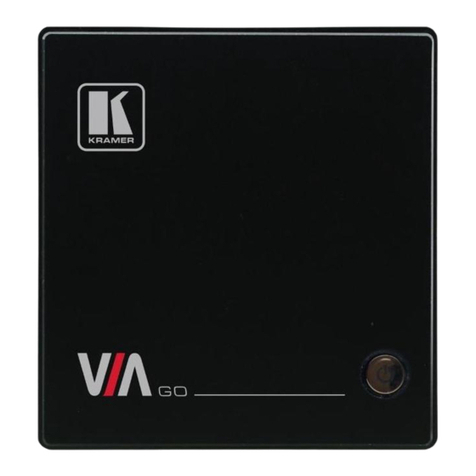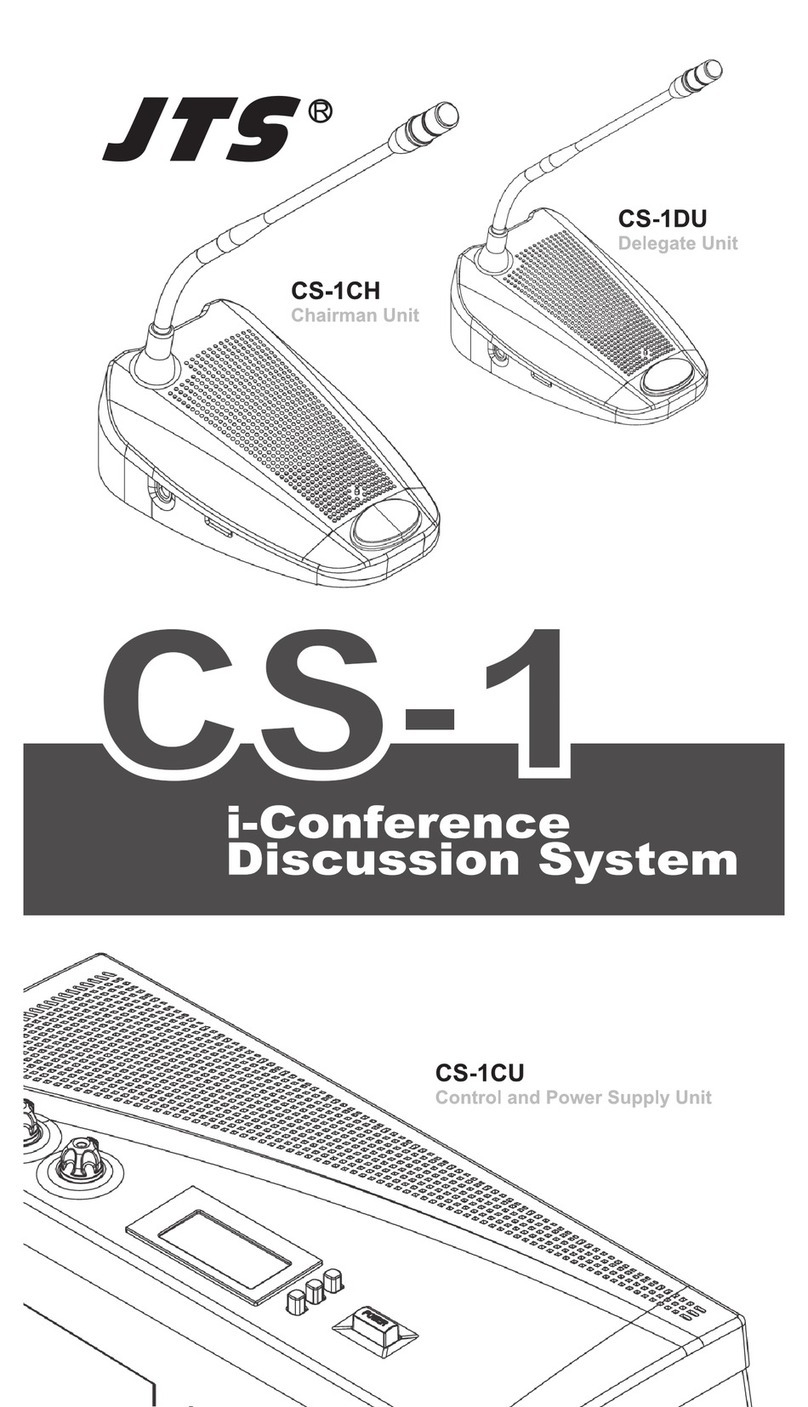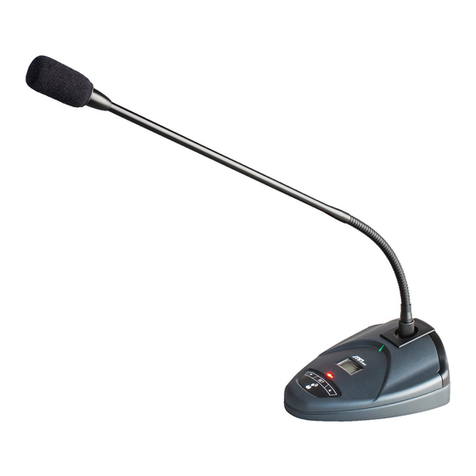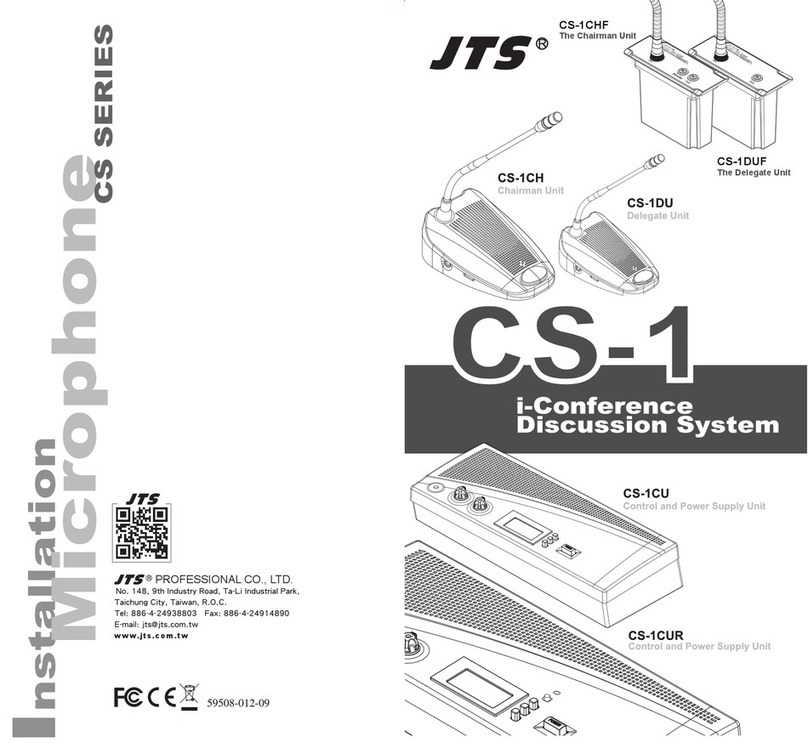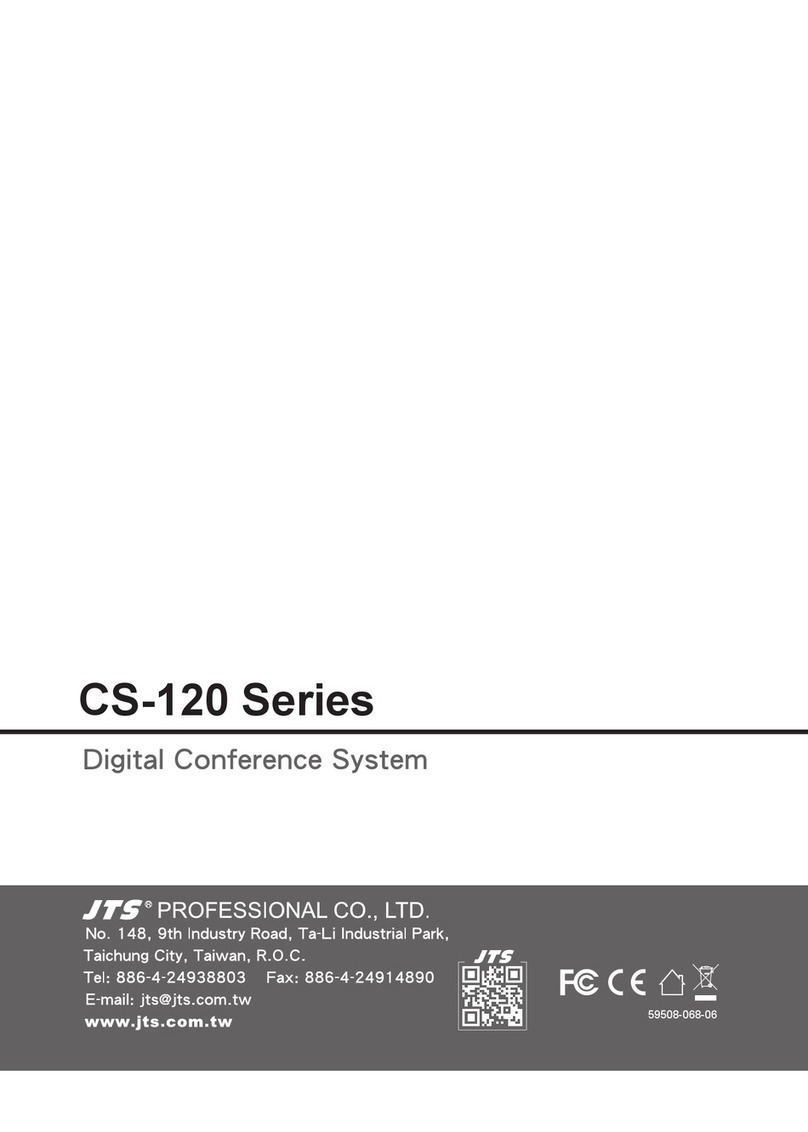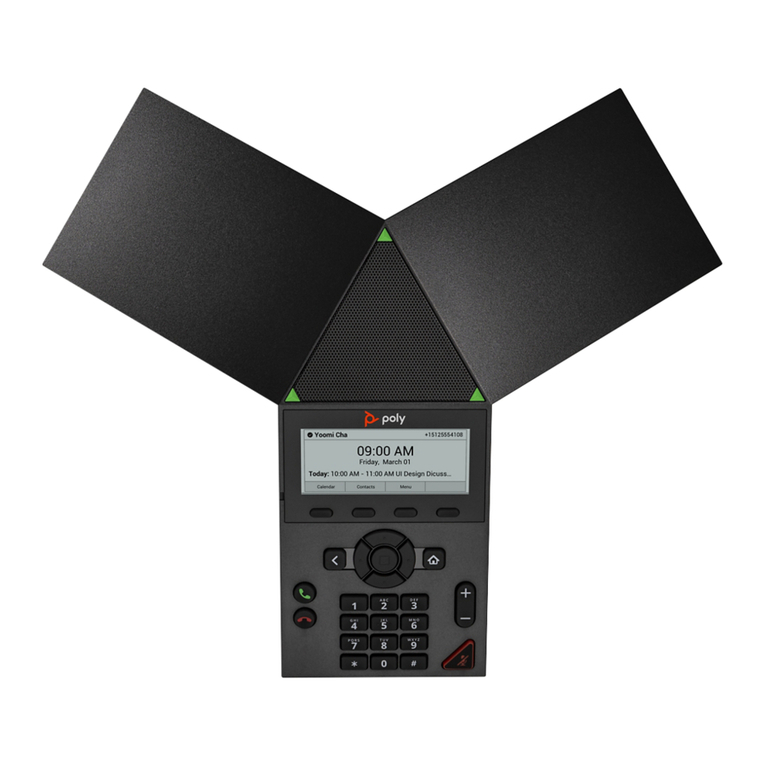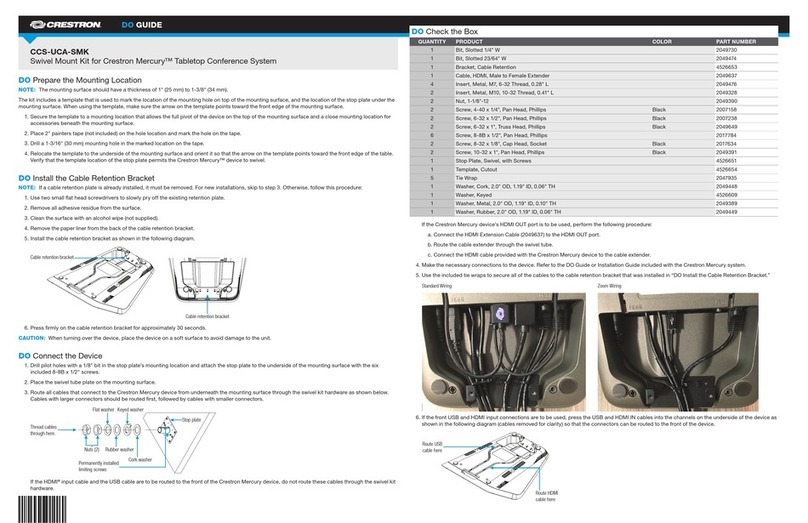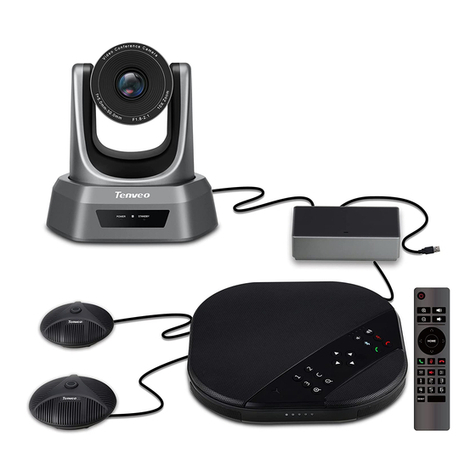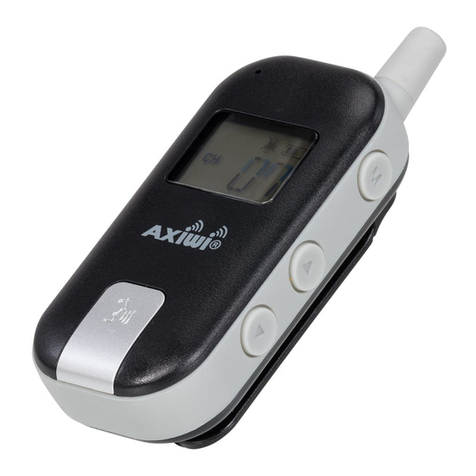kein anderes Mikrofon dazuschalten. Ein Teilneh-
mer mit einer weiteren Wortmeldung muss warten,
bis einer seiner Vorredner sein Mikrofon wieder
ausgeschaltet hat.
Ein Konferenzleiter an einer Sprechstelle CS-
1CH ist von dieser Beschränkung ausgenommen.
Er kann sein Mikrofon jederzeit über die Sprech-
taste (27) ein- und ausschalten.
„Timer Mode“
Diese Betriebsart funktioniert wie „Open Mode“,
jedoch wird ein Mikrofon, nachdem es 30 s einge-
schaltet war, automatisch abgeschaltet. Dadurch
wird verhindert, dass ein Teilnehmer auf Dauer die
Diskussion anderer Teilnehmer blockiert, wenn er
z. B. vergessen hat, sein Mikrofon auszuschalten.
3)
Nur bei den Betriebsarten „Open Mode“ und „Timer
Mode“:
Die Taste SET drücken: das Symbol blinkt.
Mit der Taste oder die gewünschte maximale
Anzahl gleichzeitiger Sprecher (1 – 4) einstellen.
4) Mit der Taste SET die Auswahl bestätigen.
Im Display erscheint kurz „Saving“ und das Einstell-
menü wird verlassen.
5.2 Bedienung der Sprechstellen CS-1DU
1) Zum Einschalten des Mikrofons die Sprechtaste
(27) kurz drücken. Die LED (23) und der Ring (22)
leuchten, sobald das Mikrofon eingeschaltet ist.
Hinweis:
Das Einschalten kann aber auch durch das
Steuergerät (Kap. 5.1) oder über die Vorrangtaste
einer Konferenzleitersprechstelle (Kap. 5.3.1)
verhindert sein.
2) Beim Anschluss eines Kopfhörers an eine der
Buchsen (24) wird der Lautsprecher (25) der
Sprechstelle abgeschaltet. Die Kopfhörerlautstärke
kann, abhängig von der am Steuergerät eingestell-
ten Maximallautstärke, mit dem Regler (30) an der
rechten Seite der Sprechstelle für beide Buchsen
gemeinsam eingestellt werden.
3) Zum Ausschalten des Mikrofons die Sprechtaste
(27) erneut drücken. Die LED (23) und der Leucht-
ring (22) erlöschen.
Hinweis:
Das Ausschalten kann auch durch das
Steuergerät (Kap. 5.1) oder über die Vorrangtaste
einer Konferenzleitersprechstelle (Kap. 5.3.1)
vorzeitig erfolgen.
5.2.1 Mikrofonempfindlichkeit einstellen
Mit dem Regler GAIN (31) auf der Unterseite jeder
Sprechstelle kann mithilfe eines kleinen Schrauben-
drehers die Verstärkung eingestellt und damit die
Empfindlichkeit des Mikrofons an einen Sprecher an-
gepasst werden.
5.3 Konferenzleitersprechstellen CS-1CH
Das Ein- und Ausschalten des Mikrofons über die
Sprechtaste sowie die Einstellung der Kopfhörerlaut-
stärke und der Mikrofonempfindlichkeit der Konferenz-
leitersprechstellen CS-1CH erfolgt wie bei den
Sprechstellen für die übrigen Konferenzteilnehmer
(Kap. 5.2). Das Mikrofon kann aber jederzeit durch
den Konferenzleiter eingeschaltet und nur durch ihn
wieder ausgeschaltet werden.
5.3.1 Vorrangtaste
Die Vorrangtaste bietet dem Konferenzleiter die Mög-
lichkeit, eine Diskussion zwischen Konferenzteilneh-
mern zu unterbrechen. Solange die Vorrangtaste (26)
gedrückt wird, bleiben die Mikrofone aller Teilnehmer-
sprechstellen ausgeschaltet. Durch die Einstellung der
beiden Schalter auf der Unterseite der Konferenzlei-
tersprechstelle kann das Verhalten beim Drücken und
Loslassen der Vorrangtaste bestimmt werden:
linker Schalter (32)
obere Position: beim Drücken der Vorrangtaste
ertönt ein Signal
untere Position: beim Drücken der Vorrangtaste
ertönt kein Signal
rechter Schalter (33)
obere Position: nach dem Loslassen der Vorrang-
taste bleiben die Mikrofone aller
Teilnehmersprechstellen ausge-
schaltet
untere Position: alle Mikrofone der Teilnehmer-
sprechstellen, die vor dem Drü-
cken der Vorrangtaste einge-
schaltet waren, werden nach dem
Loslassen der Taste automatisch
wieder eingeschaltet
5.4 Lautstärkeeinstellungen am Steuergerät
5.4.1 Gesamtlautstärke
Mit dem Regler (4) die Lautstärke aller Lautsprecher
und die maximale Lautstärke aller Kopfhöreranschlüsse
am Steuergerät und an allen angeschlossenen Sprech-
stellen einstellen. Tritt ein Rückkopplungspfeifen auf,
weil z. B. die Sprechstellen zu eng beieinander stehen
und die Mikrofonempfindlichkeit an den Sprechstellen
sehr hoch eingestellt ist (Kap. 5.2.1), den Regler
entsprechend niedriger einstellen. Der Regler hat 11
Schaltpositionen, in Position „0“ sind alle Lautsprecher
und Kopfhörer ausgeschaltet. Der Signalpegel am Aus-
gang „Recorder out“ (15) wird durch den Regler nicht
beeinflusst.
VORSICHT Stellen Sie die Kopfhörerlautstärke
nie sehr hoch ein. Hohe Lautstärken
können auf Dauer das Gehör schädi-
gen! Das Ohr gewöhnt sich an sie
und empfindet sie nach einiger Zeit
als nicht mehr so hoch. Darum eine
hohe Lautstärke nach der Gewöh-
nung nicht weiter erhöhen.
7
DEUTSCH
